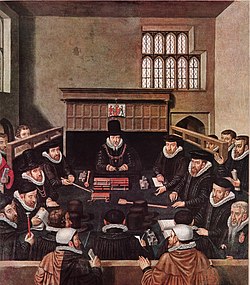
Thomas Seckford or Thomas Sakford[1] Esquire (1515–1587) was a senior lawyer, a "man of business"[2] at the court of Queen Elizabeth I, a landowner of the armigerous Suffolk gentry, Member of Parliament,[1][3] and public benefactor of the town of Woodbridge.[4] He was one of the Masters in Ordinary of the Court of Requests to Queen Elizabeth, 1569–1587, and was Surveyor of the Court of Wards and Liveries 1581–1587.[5] He built mansions in Woodbridge, Ipswich and Clerkenwell, and was at different times Steward of the Liberty of Ely (St Etheldreda) in Suffolk, Bailiff for the Crown of the former possessions of Clerkenwell Priory in the City of London and County of Middlesex, and deputy Steward for the northern parts of the Duchy of Lancaster (to which he owed his early patronage).[1] He was the patron of Christopher Saxton in the making of the first surveyed County Atlas of England and Wales.
The received portrait of Thomas Seckford, as it appears on Loder's 1796 token, as frontispiece to Loder's 1792 printing of Seckford's original Statutes for the Almshouses which he founded in Woodbridge,[6] and in other recensions, was derived by the Woodbridge artist Isaac Johnson (c. 1754–1835)[7][8] from a 16th-century painting[9] depicting William Cecil presiding over the Court of Wards and Liveries. The figure identified as Seckford wears a tall patterned hat and sits at the table on the mid-left of the early painting. The possible identification as Seckford was made in the caption to an engraving by George Vertue after the original painting,[10] published by the Society of Antiquaries of London in 1747 for the Vetusta Monumenta, noting that the figure is likely to be the Surveyor because he wears his tall hat in the presence of the Master.[11]
He is not to be confused with his younger brother, Thomas Seckford of Ludlow, also a member of parliament,[12] nor with his father, also Thomas Seckford (of Great Bealings), nor with his nephew Thomas Seckford, buried at Trinity College, Cambridge.
- ^ a b c M.K. Dale, 'Seckford (Sakford), Thomas (1515/16-87), of Gray's Inn, London', in S.T. Bindoff (ed.), The History of Parliament: the House of Commons 1509–1558 (from Boydell and Brewer 1982), History of Parliament Online.
- ^ For the meaning of this term, see 'Puritans, Men of Business and Parliaments' in P. Collinson, Elizabethan Essays (Hambledon, London and Rio Grande 1994), pp. 59–86, at p. 65.
- ^ Anon, 'Seckford, Thomas I (1515 or 1516–87), of Woodbridge and Ipswich, Suff. and Clerkenwell, London', in P.W. Hasler (ed.), The History of Parliament: the House of Commons 1558–1603 (from Boydell and Brewer 1981), History of Parliament Online.
- ^ A.D. Briscoe, A Tudor Worthy: Thomas Seckford of Woodbridge (East Anglian Magazine Limited, 1979).
- ^ J.H. Baker, 'Seckford, Thomas (1515/16–1587)', Oxford Dictionary of National Biography (Oxford University Press, 2004), superseding Cooper, Thompson (1897). . Dictionary of National Biography. Vol. 51. pp. 173–174.
- ^ R. Loder, The Statutes, and Ordinances, for the Government of the Almshouses in Woodbridge, in the County of Suffolk, Founded by Thomas Seckford, Esquire (R. Loder, Woodbridge/J. Nichols, London/G. Jermyn, Ipswich/T. Miller, Halesworth, 1792), full page views at Google.
- ^ J.M. Blatchly, Isaac Johnson of Woodbridge: Georgian Surveyor and Artist (D.K. and M.N. Sanford, Ipswich 2014).
- ^ 'Thomas Seckford and his Almshouses', in E. Griffith, A Jacobean Company and its Playhouse: The Queen's Servants at the Red Bull Theatre (c. 1605–1619) (Cambridge University Press, 2013), pp. 32–40, at p. 33, Fig. 3 (Google).
- ^ The original is in the collections of His Grace the Duke of Richmond at Goodwood House, West Sussex.
- ^ Then in the possession of Charles Lennox, 2nd Duke of Richmond. The caption refers to the "right" side, in the heraldic sense of "dexter".
- ^ A copy of the engraving, "A View of the Court of Wards and Liveries", with caption, is held at The British Museum, Prints online Museum no. Y,5.121. (The British Museum). View another copy at a Digital Vetusta Monumenta (Vol. 1 Plate 70), at missouri education.
- ^ J.J.C., 'Seckford, Thomas II (d.c.1579), of Ludlow, Salop', in P.W. Hasler (ed.), The History of Parliament: the House of Commons 1558–1603 (from Boydell and Brewer 1981), History of Parliament online.